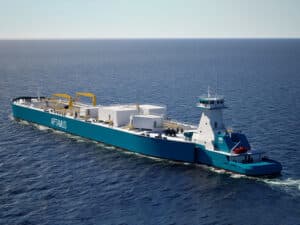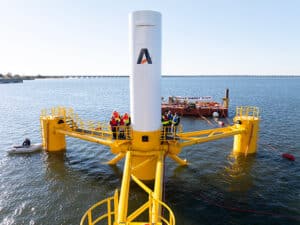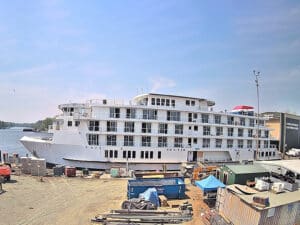
Titan submersible: Debris consistent with “catastrophic loss of pressure chamber”
Written by Nick Blenkey
First Coast Guard District commander Rear Adm. John Mauger told press briefing that debris field had been positively identified as remnants of the Titan submersible.
Dashing any lingering hopes raised by sounds detected in the area, the latest media briefing from the Unified Command makes it clear that the OceanGate Expeditions Titan submersible imploded in the water somewhere above the wreck of the Titanic, almost certainly at some time before sonar buoys were lowered into the water as part of the massive search and rescue effort.
It seems increasingly probable that the implosion occurred early in the submersible’s descent. National Public Radio (NPR), and other media sources are reporting that the Navy detected “an anomaly consistent with an implosion or explosion” in acoustic data taken from the same area where the Titan went missing. The Navy registered that data Sunday, and immediately shared it with the Coast Guard.
As the data, likely gathered by the Navy’s Integrated Undersea Surveillance System, was not definitive, the massive search and rescue operation continued.
All five of those inside the submersible must be presumed dead.
That news came after a debris field had been found by an ROV near the Titanic wreck site. First Coast Guard District commander Rear Adm. John Mauger told a press briefing that the debris field had been positively identified as remnants of the Titan submersible and that analysis of it was consistent with a catastrophic loss of the vessel’s pressure chamber.
While this provides some closure, it leaves many questions to ponder, not least as to how, and even whether, operations such as those conducted by Oceangate Expeditions should be regulated. As the Titan was loaded onto a Canadian vessel and then launched into international waters, it fell outside the current regulatory framework.
Extensive media reporting on the incident reveals that serious doubts about the safety of the Titan have been raised since at least 2018, including some that emerged in a since-settled lawsuit between its operator, OceanGate Expeditions, and its previous director of marine operations. You can read the New Republic reporting on that HERE.
In its reporting, The New York Times uncovered a 2018 letter from leading members of the Marine Technical Society to OceanGate CEO Stockton Rush expressing their “unanimous concern regarding the development of Titan and the planned Titanic Expedition” and saying that “our apprehension is that the current experimental approach adopted by Oceangate could result in negative outcomes (from minor to catastrophic) that would have serious consequences for everyone in the industry.”
The writers urging that at, a minimum, Rush “institute a prototype testing program that is reviewed and witnessed by DNV-GL (or ABS).While this may demand additional time and, expense, it is our, unanimous view that this validation process by a third-party is a critical component in the safeguards that protect all submersible occupants.”
A 2019 blog post on the OceanGate website that the New York Times cites defended the company’s position on certification. Citing the time taken for certification, it said:
“Bringing an outside entity up to speed on every innovation before it is put into real-world testing is anathema to rapid innovation.”
Stockton Rush was one of the five aboard the vessel when it suffered a catastrophic failure.




